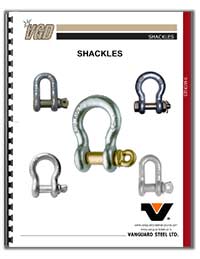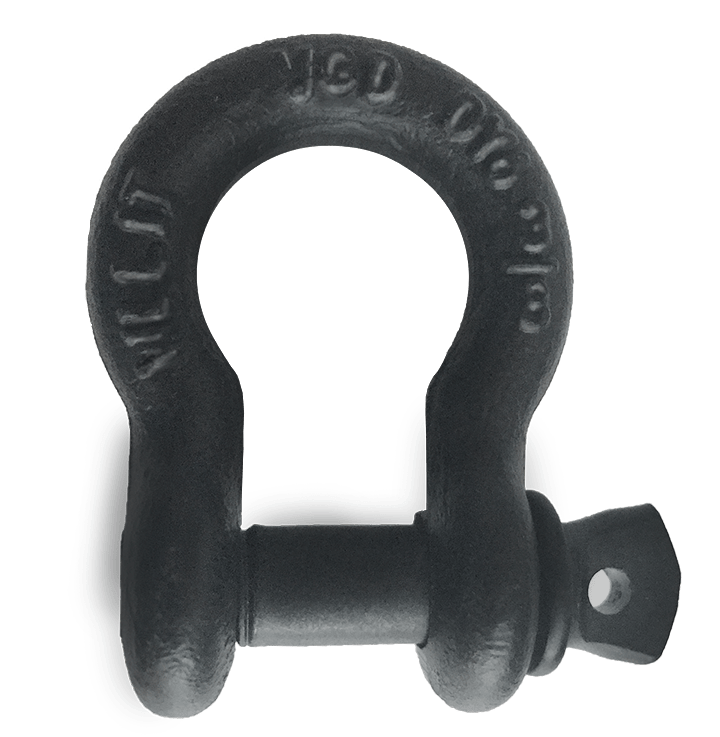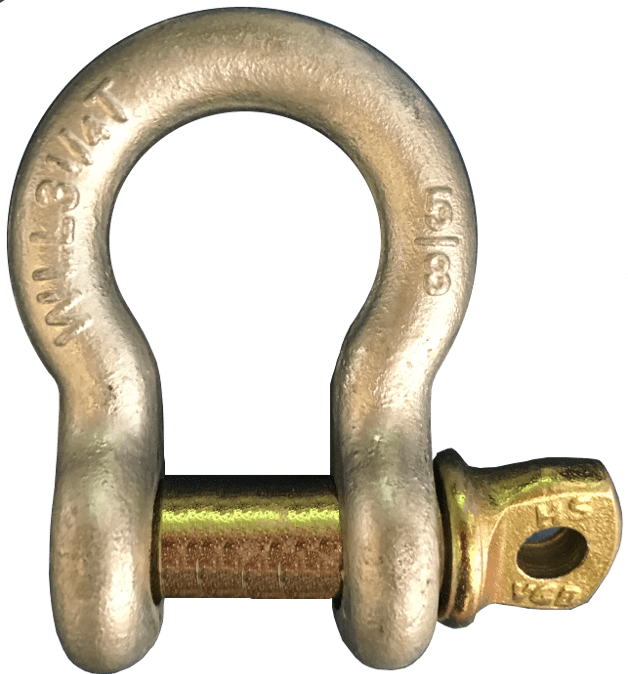
Golden Pin Can meet DNV impact requirement of
42 joules (31ft.lbs.) at -20 degrees C (-4 degrees F)
Shackles
Vanguard's GP shackles are made to comply with U.S. Fed. Specs RR-C-271D, Type IV A, Grade A, Class 2, and ASME B30.26
Temp Rating Low – High
-40f maximum
400f maximum
ASME B30.26-2015
Section 26-1.6: EFFECTS OF ENVIRONMENT
26-1.6.1 Temperature
When shackles are to be used at temperatures above
400°F (204°C) or below −40°F (−40°C), the shackle manufacturer
or a qualified person should be consulted.
VGD Gold Pin Shackles should not be subjected to high or low temperatures that could affect thermal treatment and the strength of the shackle.
Note: Per ASME B30.26 shackles are rated for temperatures between -40°F to 400°F.
If shackles are to be used in temperatures above or below these ranges, the manufacturer and/or a Qualified Person should be consulted.
Our golden pin shackles have been quenched and tempered and can meet DNV impact requirements of 42 joules (31ft.lbs) at -20 degrees C (-4 degrees F).
Lets talk about the cold which is more likely what you’ll encounter because we know our weather can’t reach 400f or 204c.
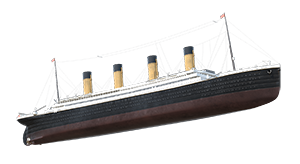
A TITANIC QUESTION
We've been getting a lot of requests from end-users about the operating temperature for our Golden Pin shackles.
A TITANIC QUESTION
We’ve been getting a lot of requests from end-users about the operating temperature for our Golden Pin shackles.
So why is this a Titanic question?
It wasn’t the fact that Rose lost Jack Dawson or that Rose threw a perfectly priceless diamond over the stern of the ship many years after…
It is believed that a large contributing factor to the Titanic sinking was due to poor steel performance at cold temperatures.
Yes, the ship hit an iceberg and the musicians kept playing, however, the steel composition of the hull wasn’t equipped to handle cold temperature and became brittle and fractured. Had this happened in warmer water the outcome could have been vastly different.
Now that we have Rose and Jack out of the way we can talk more about why.
For the nerdier, here is a little information on the why.
There are a few elements that have a direct impact on steel in cold weather:
-Carbon
- The more carbon, the more brittle the steel.
-Nickel
- Nickel increases hardenability and toughness,
-Manganese
- Increased manganese, increase hardness. It’s also an Austenite stabilizer that lowers the eutectoid temperature, thereby expanding the austenite phase field (i.e., temperature range over which austenite is stable). I’ll be honest, this is above basic nerdy.
Why do we care about cold temperatures?
It is important because of the reaction of steel when subjected to cold temperatures.
Like what happened to the sinking of the Titanic the molecular state of the grain will change as the temperature drops causing a reduction in ductility/elongation. When this happens, the steel will no longer show as many signs before braking. Metals that are typically ductile at room temperature may lose that in the colder temperature and become stiffer and therefore brittle.
The brittle transition temperature is the temperature where fractures in steel change from ductile to brittle. In other words, instead of bending, it breaks. The temperatures will differentiate based on how the steel is composed, the profiles, and heat treating. If people are using steel below temperatures of -20 it means that an engineer cannot accurately predict the mode of failure in the low-temp zone. Any brittle failure will be catastrophic, but the failure won’t necessarily be predictable. It will be from a random impact, dynamic loading, or propagate out of a crack or nick.
Charpy impact test, or V-notch test, is utilized to determine the amount of energy absorbed by steel during a fracture. The energy absorbed gives a measurement of toughness and helps determine the brittle transition temp. Two criteria needed to run the test are the amount of load (in foot/pounds) and the temperature of the sample. The test is relatively quick and cost-effective. It confirms that the steel will be able to stand up in weather conditions required for the end-user.
Why don’t more factories do these tests?
- There is no requirement under the regulations to do this.
- There is no guarantee that you will be able to obtain the results to meet the requirements.
The way steel reacts at room temperatures will not give you any indications of how well it will perform at low temperatures. Meaning you can have a perfectly fine shackle that tests within specs but subject it to cold temps and it fails the DNV impact test. That’s another reason why they don’t do the test.
Meeting the 42 joules lets the user know the steel used here is still predictable.
- Our Golden Pin shackles can meet DNV impact requirements of 42 joules (31ft.lbs) at -20 degrees C (-4 degrees F)
For a lot of applications and as long as the user doesn’t push the safety factors there shouldn’t be an issue, however, a lot is riding on it.
Vanguard’s Golden Pin Shackles stand out as a trademarked and top-tier product due to their adherence to stringent industry specifications and commitment to quality:
Compliance with Industry Standards: The Golden Pin Shackles meet U.S. Federal Specifications RR-C-271D, Type IV A, Grade A, Class 2, and exceed ASME B30.26 standards. This commitment to adhering to, and often surpassing, industry benchmarks underscores their reliability and suitability for various applications.
Certifications and Memberships: Vanguard’s factories are certified by DNV-GL under ISO9001, showcasing a dedication to quality management systems. Additionally, being members of the Associated Wire Rope Fabricators (AWRF) and the Web Sling & Tie-Down Association reflects Vanguard’s commitment to industry best practices and staying informed about the latest advancements.
Exceptional Performance: The Golden Pin Shackles surpass DNV impact requirements, demonstrating their resilience even in challenging conditions. The incorporation of safety markers on the bow, conforming markings, and compliance with lifting regulations further emphasize Vanguard’s dedication to ensuring user safety and proper usage.
Decades of Experience: With over 60 years of experience in the industry, Vanguard brings a wealth of knowledge and expertise to the design and manufacturing of Golden Pin Shackles. This extensive experience speaks to the brand’s reliability and ability to consistently deliver quality products.
Quality Consistency: Vanguard prioritizes the consistency of quality over pricing considerations, affirming a commitment to providing reliable and durable shackles. This emphasis on quality control ensures that each Golden Pin Shackle meets or exceeds the expected standards, contributing to their reputation for reliability and durability in the market.

SHACKLE VIDEO
Why buy VDG Golden Pin shackles? Because they not only meet the performance requirements of:
- U.S. Fed. Specs RR-C-271D, Type IV A, Grade A, Class 2.
- And ASME B30.26, but they exceed them.
- Our factories are DNV-GL ISO9001 certified.
- AWRF and WEB SLING & TIE-DOWN ASSOCIATION members.
- Can meet DNV impact requirement of 42 joules (31ft.lbs.) at -20 degrees C (-4 degrees F)
Buy VANGUARD because you don’t need to compromise on safety.
Vanguard Steel for all your critical rigging products.
What to look for when inspecting shackles
When inspecting a shackle, it’s crucial to thoroughly assess its condition to ensure safety and reliability. Here are five key aspects to consider during a shackle inspection:
Visible Damage or Deformation:
- Examine the shackle for any visible signs of damage, such as bends, cracks, or deformities. Pay close attention to the body, pin, and any load-bearing surfaces. If any visible damage is detected, the shackle should be taken out of service immediately.
Wear and Corrosion:
- Check for wear, corrosion, or pitting on the shackle’s surfaces. Excessive wear can compromise the strength of the shackle, while corrosion or pitting can weaken the material. Address any signs of wear or corrosion promptly and consider the environmental conditions in which the shackle is used.
Proper Function of Moving Parts:
- If the shackle has a movable pin or any other moving parts, ensure they function correctly. The pin should move freely without binding. Verify that the pin’s threads are intact and that it can be securely tightened and locked in place.
Markings and Identification:
- Check for the manufacturer’s markings, load rating, and any relevant certifications on the shackle. Ensure that the shackle’s specifications match the requirements for its intended use. If markings are illegible or missing, it may be challenging to determine the shackle’s suitability and compliance with standards.
Load Rating and Working Load Limit (WLL):
- Confirm that the shackle’s load rating and working load limit (WLL) are appropriate for the intended application. The WLL is the maximum load the shackle is designed to handle under normal working conditions. Using a shackle with an insufficient WLL can lead to failure and pose a significant safety risk.
Remember that regular inspections are crucial to maintaining the safety and reliability of shackles. If any issues are identified during the inspection, replace the shackle immediately, and always follow the manufacturer’s guidelines and industry standards.
Conversion chart
| Description | Vanguard | Crosby | CM | Van Beest |
| Anchor shackle | 2902 | G209 | MC6**G | G4161 |
| Chain Shackle | 3912 | G210 | MC7**G | G4151 |
| Safety Shackle | 2914 | G2130 | MC8**G | G4163 |
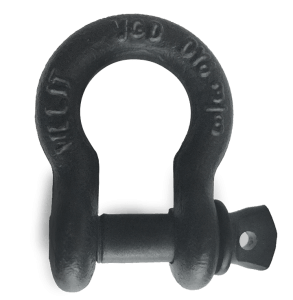
VGD Theatrical Shackle Black
Black Anodized Finish
meeting the performance requirements of U.S. Fed. Specs RR-C-271D, Type IV A, grade A, Class 2
Vanguard Steel VGD Theatrical Shackle is designed for theatrical use. Anodized black colour hides the theatrical rigging. The VGD Theatrical Shackle can be used for overhead lifting, hanging or hoisting on stage. Our Shackles meet the performance requirements of U.S. Fed. Specs RR-C-271D, Type IV A, grade A, Class 2. and have a 6:1 safety design factor.
Theatrical Shackles are specially designed where dark, non-reflective shackles are preferred such as is needed in the entertainment industry.



